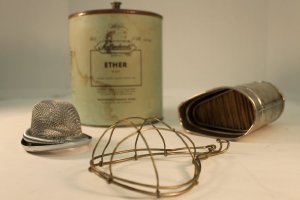Before the 1840s, anesthetics were soporifics, which dull the senses and induce sleep, or narcotics. These included opium, jimsonweed, marijuana, alcohol and belladonna. Native American groups often chewed coca leaves for the desired anesthetic effect. Sometimes the patient needing surgery was given a blow to the head and rendered unconscious. Unfortunately, many times the patient woke during the surgical procedure. Other drawbacks to the use of alochol and narcotics was that the patient could become addicted or the amount necessary sometimes resulted in death from overdose.
The 1840s brought the development of chloroform, ether, and nitrous oxide. By the early 1900s, chloroform was no longer used in favor of ether because if its high toxicity.
When the Civil War started in 1861, the use of anesthesia was still in it's infancy. The huge number of casualties gave surgeons on both sides of the conflict the opportunity to gain experience in the use of ether and chloroform. However, records show that while anesthesia was used approximately 125,000 times during the Civil War, many did not receive any anesthesia. The number of wounded was 476,000 and the number killed was 620,000, many of which likely received some surgical care, far outnumbering those that received anesthesia.
Today, there is a wide variety of anesthetics available and many still contain derivitives of some of these early substances, such as morphine, cocaine, and nitrous oxide.
The Anesthesia collection at the Edward Hand Medical Heritage Foundation includes items dating from the late 19th century to the mid 20th century.
